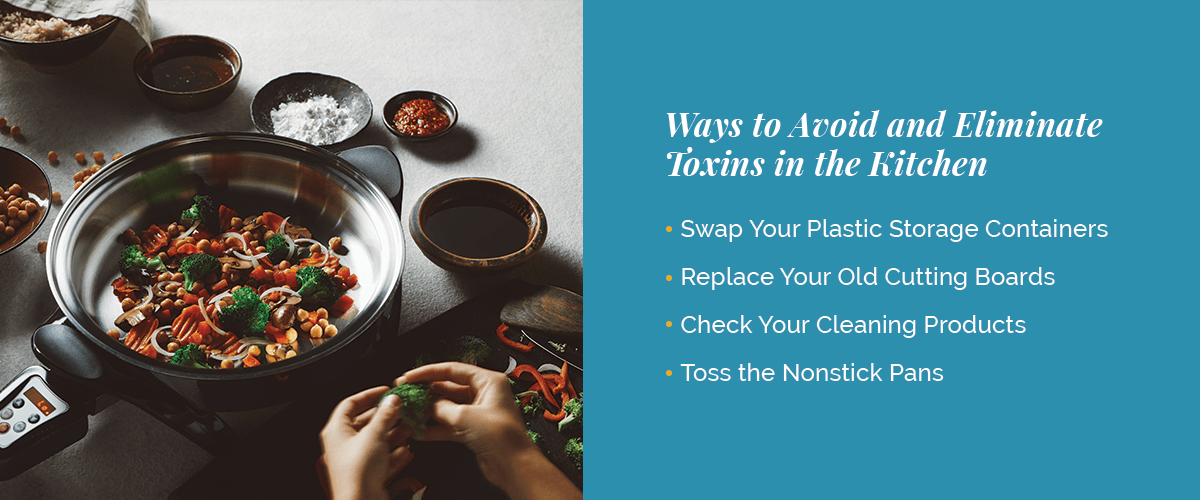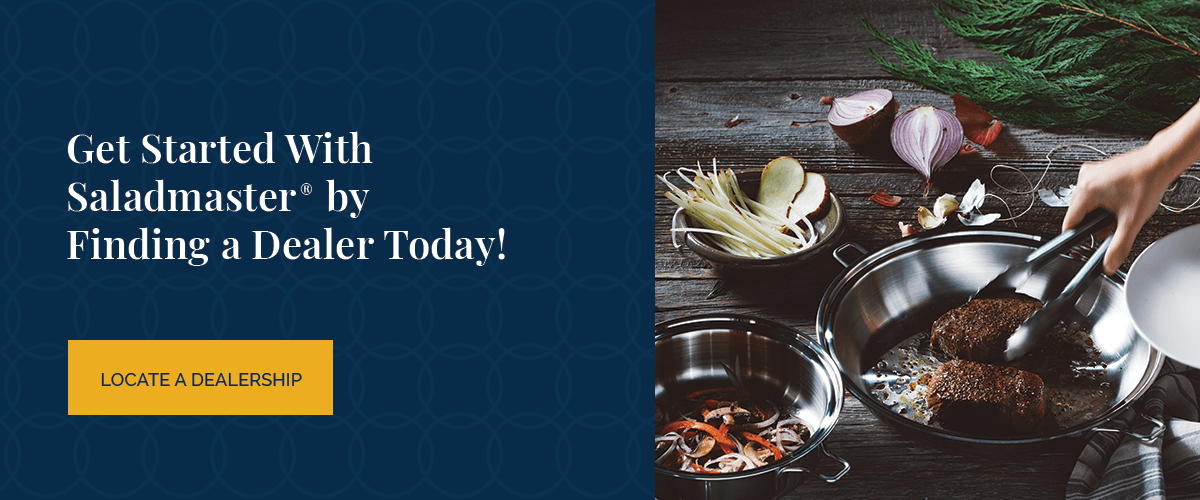Top Ways to Avoid Toxins in the Kitchen
Leading a healthy lifestyle doesn't require extreme changes. Avoiding toxins in your kitchen is a simple way to make a significant difference. Learn more here.
Living a healthy lifestyle looks different for everyone. Whether you're trying to change your own habits or encourage your entire family to eat healthier and be more active, improving your health starts with making small changes. These changes generally begin in your kitchen, where you'll spend a considerable amount of time choosing and preparing nutritious meals.
After putting in the effort to cook at home instead of eating out, it can be frustrating to learn that our own kitchenware contains environmental toxins that can lead to a wide range of health issues. While some people believe that everyday toxins are impossible to avoid, there are plenty of ways we can eliminate our exposure and reduce our health risk using quality kitchen tools.
Types of Toxins in Kitchen
Unfortunately, even when we try to consciously avoid preservatives, artificial coloring and chemicals in our foods, our own cooking materials may be hiding these toxins in plain sight. Here are some different types of toxins that you may find in your kitchen:
- Bisephenol-A (BPA): Something as simple as putting your food in plastic storage containers can expose you and your family to BPA, a harmful chemical known to be an endocrine disruptor. Some canned foods may also be lined with BPA. Be sure to never heat anything in a plastic container.
- Cadmium: While glassware is often considered safer than plastic products, certain glazes, coatings or paints on glass may contain cadmium. This agent is considered a cancerous chemical and is listed as a Group 1 carcinogen by the International Agency for Research on Cancer.
- Perfluorinated chemicals (PFCs): Many nonstick cookware contains PFCs, which are synthetic resins that can leak into your food when heated. PFCs refer to a larger group of chemicals that includes per- and polyfluoroalkyl substances (PFASs), which present health risks like liver damage and high cholesterol.
- Polytetrafluoroethylene (PTFE): Like PFCs and PFASs, nonstick pans and cookware also often contain PTFE, which can flake off into your food when heated or scraped using utensils. PTFE, also called Teflon, can increase the risk of certain cancers and flu-like illnesses.
- Polyethylene (LDPE) and polyvinylidene chloride (PVDC): If you've decided to ditch your old plastic storage containers and switch to plastic wrap for your leftovers, you may still have dangerous chemicals leeching into your food. Plastic wraps are generally made with LDPE or PVDC, which can be especially toxic if you microwave your food with the plastic still attached.
The Dangers of Toxins
Though we briefly noted some dangers of common kitchen toxins above, it's important to know just how many side effects, chronic illnesses, diseases and conditions you and your family may be at risk for after long-term exposure to these toxins from your everyday kitchenware.
Over time, toxins and chemicals that leak into food from cookware can lead to many health issues ranging from mild to severe, lifelong conditions. For instance, Cadmium is associated with vomiting and diarrhea, which may go away after a day or so. However, it's also associated with lung damage, kidney disease and many other health conditions.
Materials and products made with PFASs can lead to the inhalation of carcinogens. BPA, found in most plastic products, is known to be harmful to humans and animals as it may increase your risk for hypertension and cardiovascular disease, as well as endocrine, immune and oncological diseases.
Low-density polyethylene (LDPE), which is found in many plastic kitchenware like plastic wrap, has been found to contain arsenic. This toxic carcinogen can result in damage to the lungs, skin, bladder, kidney and gastrointestinal system.
One of the most concerning dangers of toxin exposure is the increased risk of developing various types of cancer. Products that contain cadmium and PFAFs, in particular, are associated with lung, kidney, testicular, ovarian, thyroid and other cancers.
Ways to Avoid and Eliminate Toxins in the Kitchen
It can often seem impossible to live a healthy lifestyle when you uncover all the sneaky, hidden chemicals that may be in your everyday household items. However, you can avoid and eliminate toxins in your kitchen to keep your family safer using the following tips.

1. Swap Your Plastic Storage Containers
Heating your food in a plastic container is never a good idea. Many plastic containers are made with BPA and other harmful chemicals that get absorbed into food when heated. Instead, recycle all your plastic kitchenware and exchange it for plain glass, ceramic or stainless steel options.
You'll also want to avoid plastic or styrofoam cups, plates or to-go containers. These items contain many hazardous substances and chemicals that interact with our food, so it's best to steer clear of them. If you'd like to keep some disposable options on hand in your kitchen, stick to paper plates and cups.
2. Replace Your Old Cutting Boards
Like many of us, you probably have some old, tried-and-true cutting boards that have been in your kitchen for years. However, if your old plastic cutting boards have many deep cut marks and grooves, there are more opportunities for bacteria to get trapped and grow.
Whether you hand wash or use the dishwasher for your cutting boards, you may not be able to clean in the small, deep grooves enough. In addition, many plastic cutting boards have chemical additives that give them their texture and color, which means they may contain glue and other toxins that may leach into your food over time as the outer layer weakens.
3. Check Your Cleaning Products
Even if you invest in quality kitchenware and healthier alternatives, you may still be introducing toxins into your kitchen through your cleaning products. A simple way to help your family avoid unnecessary chemicals is by looking at the ingredients in your cleaning products to make better-informed decisions about what products you use in your kitchen. As a general rule of thumb, look for eco-friendly or biodegradable cleaners for your kitchen.
You can even create an all-purpose cleaner for most surfaces and projects by combining natural ingredients like water, soap, vinegar and baking soda. This combination creates a homemade scrub for your entire kitchen, keeping surfaces clean while eliminating toxic chemicals.
4. Toss the Nonstick Pans
After years of trying to find pans that don't leave crusty, leftover food on them after cooking, it can be a real bummer to learn your favorite cookware actually poses a threat to your health. Many nonstick pots, pans, slow cookers and bakeware contain PFSASs.
When heating your food, you're also heating the chemicals contained in the nonstick coatings on your cookware, which can break down over time and become absorbed into the food you eat. Your best bet is to choose healthy vessels for cooking. For a natural way to a healthier lifestyle, consider high-quality, durable stainless steel cookware. Stainless steel is nonreactive, meaning it won't break down, scratch or rust under high temperatures, making it an ideal option for your kitchen
Get Started With Saladmaster® by Finding a Dealer Today!
As you can see, there are plenty of ways to eliminate exposure to toxins in your kitchen and support your healthy lifestyle. If you're looking to invest in durable, safe cookware, check out the stainless steel pots and pans from Saladmaster. Our innovative cookware material can help lead to a better quality of life by retaining the vitamins and nutrients from your food and eliminating toxic chemicals from your kitchen.
At Saladmaster, it's our goal to make it easier for you and your family to learn to love home cooking again and transform how you prepare nutritious meals. To learn more about our cookware, browse our cookware online or locate a Saladmaster dealership near you today!

12932